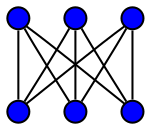

In graph theory, the Laman graphs are a family of sparse graphs describing the minimally rigid systems of rods and joints in the plane. Formally, a Laman graph is a graph on n vertices such that, for all k, every k-vertex subgraph has at most 2k − 3 edges, and such that the whole graph has exactly 2n − 3 edges. Laman graphs are named after Gerard Laman, of the University of Amsterdam, who in 1970 used them to characterize rigid planar structures.[1] However, this characterization, the Geiringer–Laman theorem, had already been discovered in 1927 by Hilda Geiringer.[2]
- ^ Laman, G. (1970), "On graphs and the rigidity of plane skeletal structures", J. Engineering Mathematics, 4 (4): 331–340, Bibcode:1970JEnMa...4..331L, doi:10.1007/BF01534980, MR 0269535, S2CID 122631794.
- ^ Pollaczek-Geiringer, Hilda (1927), "Über die Gliederung ebener Fachwerke", Zeitschrift für Angewandte Mathematik und Mechanik, 7 (1): 58–72, Bibcode:1927ZaMM....7...58P, doi:10.1002/zamm.19270070107.